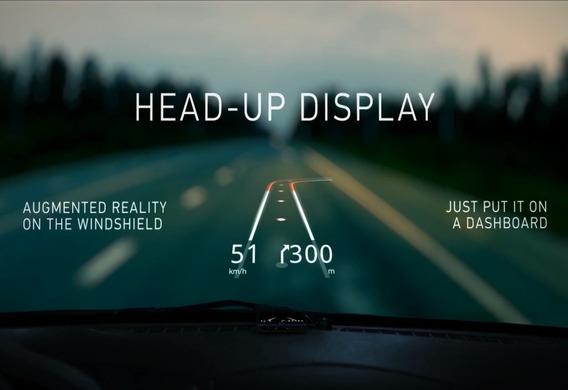
Head-up display (Head-up display or HUD) is a transparent screen that can be read from the road.
The name itself stands for "the display that allows you to read the information held high". Like much else, HUD came into the auto industry from military aviation, where such displays use fighter pilots to read the necessary data forward, not down or down.
Of course, the speed of fighters and cars is not comparable, but the pilot is not always at the wheel of the car. Today, therefore, Head-up displays are increasingly used not only in commercial aviation, but also on roads.
In Rosy, such devices are commonly referred to as windshield projectors.
Hup-up display history
The development of the HUD-s is taken from the technology of the reflector of the vision used in military aviation prior to World War II.
Initially, the data available to the pilot were limited to the gyroscope of the target, the speed of flight and the turnings. But rather soon, computer models of forecasted coal and attack speeds have been added, allowing for greater precision in the battle. One of the first examples of the current head-up display was the British Mk VIII projector system, which was installed on the night fighter Hililand Mosquito. It added an artificial horizon to the radar screen, which allowed the pilot to intercept without taking a look at the target.
The first prototype of a modern [ [ Head-up]] display was developed in 1955 by the US Navy, but the sample had many defects and no serial production. But the technology of the HUD evolved, and as early as 1958, the system is starting to be used in the Buccaneer models. And in 1960, French pilot Gilbert Klopstein was able to create a modified Head-up display with a standardised system of symbols. As a result, in 1975, HUD was included in the rules of the mission.
In 1970, the head-up display began to be used in commercial aviation and today it is standard equipment for CanadAir RJ, Airbus 318 and Boeing 787, and is certified for the following family of Airbus.
The first serial car with the Head-up in 1988 was Oldsmobile Cutlass Supreme. General Motors is using the projection on the windscreen since 1988, and the first color display was installed on Corvette C5 in 1998. Nissan launched the 240SX model from 1989 to 1994, and Toyota offered this technology in the domestic market only in 1991 in the Toyota Crown Majesta.
The first European producer, who evaluated the merits of the projector on the windshield, became in 2003 BMW, which applied the technology in the new generation of cars of the 5th and 6th episodes. Today, this system is used in H5, X6 and in the new 7.
Many modern Japanese vehicles designed for the Asia-Pacific region are equipped with a Head-up display.
Head-up Display Device and Principle
Head-up display is a light-emitting diode of the high luminance display above the dashboard of a motor vehicle, which impels the reading of these devices on the windshield in front of the driver.
The device is dockable on the front panel and projects the data on the special film that is bonded to the windscreen.
The differences between existing Heads-up display models are the set of readings on the glass and the way the information is obtained. Thus, the information about the speed of the car, but also the characteristics of the tachometer, the data about the voltage of the onboard network, the temperature of the cooling system, the state of the overall lighting, the GPS navigation, etc., can be displayed.
The data comes from special sensors that connect to the vehicle system (included in the package) or are received from satellites by the built-in GPS antenna. In the latter case, the food is fed from the cigarette lighter; therefore, it is considered preferable for vehicles under warranty and which do not allow interference in the electrical grid.
The projector is installed in any location convenient for the driver. The translucent figures are displayed right in front of him, giving the impression that they are above the road ahead.
The possibility of color or audible alarm-exceeding any given parameter results in visual or auditory warning.
The embedded luminance sensor makes it easy to read readings by day and night-symbols are not blind in the dark and are perfectly visible even in bright sunlight.

Pros and cons of the Head-up Display
The main advantage of Head-up display is, of course, the ability to constantly have the readings of the instruments in front of your eyes and not to be distracted from the road.
It is also important that the safety of the driver and the comfort of the driver are increased thanks to the warning system.
Well, the third plus the HUD can be considered as "obsession" of the device. Not every car is equipped with a similar gadget, so the attention and interest of the familiar is provided.
Among the deficiencies of the Head-up display, the owners note the need for some time to adjust to the very fact of the existence of the projection on the windshield. An unfamiliar stain is causing a feeling of being alien and, at first, seems to interfere with the review. It is true that after a few days, drivers get used to watching the symbols and stop noticing their presence.
Future Head-up Display
The developers believe that, over time, the amount of information displayed on the windshield will only increase.
Today, the Head-up display shows only static data. Ambitions of specialists apply to the withdrawal-analog indicators of everything that takes place from the outside. Thus, in Audi, for example, work to ensure that people on the edge of the road in the dark are not reduced to a simple pictogram, but to show the person exactly where it would be visible under normal illumination. Thus, the person "doubles" at night on the windshield of the car as on the screen.







